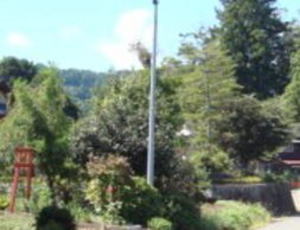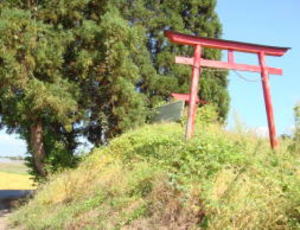districts of the town is the site of "Yōki-kan-dōjyō", it is
now the "JA Aizu Yotsuba (four leaves) staff dedicated parking".
(photo)
The times on Aizu War of Boshin, on the way to Tsuruga-jyō castle led with
the 40 disciples, it is said that it encounters the
enemy soldier, but it is said that it entered the castle safely through
the struggle. In the Meiji period, he was born in Oikeda
settlements, Hirose district, who made his name known as "Aizu no Kotengu" in later years, and he produced a very strong
martial artist who called Takeda Sōkaku was influenced modern Japanese
martial arts and the sports world.Shibuya Tōma
votive framed picture or motto to Enzō-ji temple Kikkō-dō hall in Yanaizsu
town, Kawanuma county is still in existence.
His graveyard is in Jyōrin-ji temple, and he sleeping at peace with his
wife, Yin.
(Welcome map, Aizu Bange town Central area
map)
Asparagus, which is produced throughout Aizu, Fukushima prefecture, is
in season from
April to June and can be enjoyed until around October. Depending on the production area, it
is referred to as "Kitakata Asparagus" and "Minami-Aizu
Asparagus" are called to the region
originally, and it is called "Aizu Asparagus" in its entirey.
Aizu has the 3rd largest planting
area in Japan as a regional unit, and in the season, 99% of the products distributed in
Fukushima prefecture are said to be Aizu asparagus. Because the coverage
was about noon,
it had become asparagus which grew up greatly. The photo is an asparagus
field in the
Tachikawa districts of Aizu-Bange town. Asparagus grows quickly and grows by 7cm a day,
when the harvest season comes, the farmer becomes very busy from early
morning.
In addition, it is said that the harvest is once a day during the low temperature times, and
also high and a sense of openness. When you enter the building, you will be able to relax in a relaxing space
to relieve the fatigue of
driving and touring. I sit on a chair and looked around, and saw young
women lining up. It was a Gelato shop made of local
vegetables and fruits. Its name is 12-month gelato, twelve kinds of gelato? it hear that can always enjoy 14 kinds of gelato. It is a
space of "Aizu products hall" when entering into the depths
of the crowd. Local products and specialties from the Aizu region were
lined up in Yugawa village and Aizu-Bange town, and it was full of customers
who were looking for souvenirs. And in the back, it is
a farmer's restaurant. You can enjoy meals made from ingredients produced by local farmers. On the other side is an "Agricultural
market", where you can buy fresh vegetables and fruits from the morning
produced by local farmers. Events such as the Blue-sky-
market are held in the open space "Michi-no-Hiroba" in front of the main building. Various events are also held at the dry riverbed
of nearby Ō-kawa river (Aga-kawa river). There is also a fast charging space for EVs in the parking lot.
(Welcome map, Aizu Bange
town East area map)
•Road station Business hours, 9:00 ~ 19:00 (Open all year
round)
•Farmer's Restaurant Business hours,
Lunchtime 11:00 ~ 15:00 (Last order 14:30)
Restaurant 11:00 ~ 19:00 (Last order 18:30)
•Meeting
room, Accommodates 100 peoples
•Information,
Rest room, Toilet, Available for 24 hours a day
•Parking area, Ordinary cars 100 (with temporary space)
Large vehicles 11, for Physically
handicapped person 3
for EVs chargers 2, Bicycle and Motorbike
parking area
•Tel. 0241 - 27 - 8853
•URL
http://heso-aizu.jp/
At the age of 14~15, Takeko studied Keisho and Shisho(Confucian documents),
and was able to likes to write the Poetry and Waka.
When she grew up, she learned Naginata-arts and Dagger-arts from the feudal
retainer Kurokōchi Dengorō, it is said that the
Naginata was the skill of the full proficiency. Ms Takeko is beautiful, intelligent, and excels in martial arts, said that she was in a
position to admit to yield to one be inside the Aizu clan residence. Such
a Ms Takeko, it is said Teru-hime was cute like her real
sister. When the Boshin war began, she return to original family register
in her parents' house, with her family were returning to
Aizu. The family rented the Shoin of the Tamokami Hyōgo house (facing domain school Nisshin-kan) in Yonedai Ni-no-chō (near
Yamamoto Kakuma and (Niijima) Yae brother and sister birthplace). It is now the Prefectural
Wakamatsu Commercial High
School. Ms Takeko is away from her
family and is on the related of Akaoka Daisuke, she lodge at Tamaki-dōjyō in Bange, where
Akaoka's younger brother Tamaki Tokugorō. Tamaki-dōjyō was, the east side of Akebono Shuzo brewery "Ozawa barber shop"
further east next of, it had been in the back of the house. The area where
the tree grows in the back of the photograph is Dōjyō
ruins. It is said that the Naginata was taught to women and girls of Bange
as an acting master here, and the study was taught to
children. In Aizu-Bange town, the famous episode of Ms. Takeko during
her stay in Bange, the story still continue to handed down.
"You're rude!
I’ll punishment you! " Ms. Takeko punished bad kids.
There was no bath in Tamaki-dōjyō, so she went to the Sentō (public bath)
once or twice to take a bath. Many public baths in this
period were mixed bathing, and Wakamatsu castle town and Bange were not
exception. However, it is said that it has nailed men's
eyes at once because of the grace and beauty. Ms Takeko who hated it does not go to the bath house, in the Dōjyō garden, she wash
oneself in a Tarai (portable laundry tub), and she was wiping her body
with her facecloth. One day in midsummer, Takeko was
washing oneself in a Tarai in the garden of the D
Five or six of the bad kids from Bange who heard the reputation of Ms Takeko
who had been noisy with the beautiful woman of the world in the clan came to peep. When Takeko, who was doing washing oneself
in a Tarai, sensed it, when she wear Yukata with an expression that does
not know, correct the collar at the back of the room, with
a favorite Naginata in her hand over the threshold, she softly get behind
the bad kids. And "What is it to do rude to the womenfolk
of the Samurai class! I'll punishment you! Sit down here!" she set up the Naginata in the upper position. And the cut point of the
Naginata which received the day of summer shines, bad kids were surprised
by Ms Takeko's sharp-eyes, "Oops!" to shout and they
ran out to the Goshoku shrine (Dainomiya park) in Kobange districts all
at once. Ms Takeko was who chased there, around the root
of the large zelkova, she continued to chase the bad kids who ran around again and again. The bad kids who were running around
finally ran out of energy, and they sat down weakly to the ground. Ms
Takeko at the time says that wasn’t out her breath.
"Panish!" and the bad kids to against Ms Takeko who swung up the Naginata, "We don't do it anymore,
so please forgive me." they
apologized and begged for life while rubbing there forehead against the ground at the base root of the large zelkova. Ms Takeko who
saw it, thrust the ferrule of the Naginata up to the ground, after preaching
enough, it is said to hold the Naginata under her one’s
arm, to have left the place calmly. When each bad kids goes home, it is
to say that it was considerably scolded from parents who
heard the commotion. Since then, it is said that there was no one who
peeps.
(Welcome map, Aizu Bange
town Central area map)
In a word, it is said that it was in the rice field in the Usuga-mori-kofun west where enshrined Atago shrine in the Niidate district.
Because the ground was low in this area, there were a lot of flood damage,
especially in the Shirohige-no-Ōmizu (the big flood of
the white beard) of Tenbun 5 year (1535 year), it is described to the
Ihon-Tōdera-Nagachyō (long book) the "Bange-Tōdera depth
8-Shaku (about 2.4m)". It is said that it moved to the present place to avoid repeated flood damage. It is said that the resident
settled in the north of village, and to the south the village was formed
by emigrating from Nishi(west)-Ushizawa. However, this
area at that time was high and the water supply was bad, rice paddies
were easily affected by drought, and paddy field cultivation
was extremely difficult. This can be easily judged by looking at the topography of the settlements. After the Kurimura-weir was
opened, the rice-field-open were gradually progressed. Today, the water-derivation
business for irrigation water is progressing,
and it is a settlements where fruit tree cultivation such as grapes, peaches
and persimmons is active not only in paddy cultivation.
During the season, there are also orchards where you can grape picking, you may want to contact the Aizu-Bange town Tourism
and Products Association (Tel. 0242 – 83 – 2111). When you pass by near
the orchard in the peach and grape season, it becomes
a Fruit-road with the sweet smell of the fruit.
(Welcome map, Aizu Bange
town Funasugi, Funakubo area map)
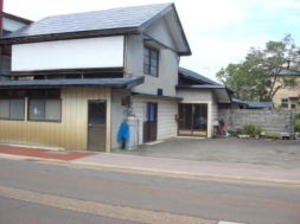
and typhoons in natural disasters caused, management abandoned or the details
of whether he left after being defeated in a
territorial battle are unknown. In any case, where it became uninhabited,
it is thought that Mr. Kurosawa of Sugi-mansion sent the
person of the relative as the village owner, and managed it as the rule
place. It is thought that the area around the Fire station post
which is called the Aza-Daimon is a ruins of mansion.
The entire region is called the "Funasugi" district in conjunction with the Sugi settlements. The origin of the name of the place of
Funakubo is said the Aizu-Onko-Jyūyōshō, Mt. Bandai erupted and uplift
in the Daidō 1 year (806 year), the 2 manors called the
Sarashina and the Tsukinowa were subsidence and Lake Inawashiro was formed.
At this time, they emigrating to this place Bange,
named Funakubo of the name of the hometown that sank in the bottom of the lake, it is said that the village was revived.
In addition, because there is a village name of Funakubo in the Tōdera
Hachiman shrine shinto pleast list of Tengi 5 year (1057
year), by this time an independent settlements had already been formed.
The Prince Shōtoku faithful statue is enshrined in the
Taishi-dō hall in the settlements, but it has been carved with the Daidō 3 year (808 Year) on the back of the Prince’s statue, and it
is written in Sumi-ink that it was repaired after the fire during in the
Kyōho years (1716 year ~ 1735 year). In addition, the Jizō-dō
hall in front of Kasuga Hachirō memorial hall is a Koyasu Jizō (Jizō for
children’s health), which is called "one cedar Jizō", and it
has been believed by the residents of the settlements to say "Kita-muki-Jizō
(north-oriented Jizō)".
(Welcome map, Aizu Bange
town Funasugi, Funakubo area map)
Fukuhara Kazaemon is a person who is originally called Uryū Kazaemon, after
reclaiming Fukuhara-new-rice-field, he named
Mr. Fukuhara from the place name, and later named Mr. Saze. It is the
ancestor of Mr. Saze of the house which set up a splendid
Nagaya-mon gate in the village. In Genna years (1615 year ~ 1624 year)
was the times of rule by Mr. Gamō Tadasato, the building
with the castle pavilion function is not built, it was a base of the regional
rule as the job title house of the Kimoiri post.
Mr. Gamō Tadasato is the grandson of Mr. Gamō Ujisato. Immediately after
the fall of Mr. Ashina in the Aizu invasion of Date
Masamune, Mr. Gamō, becomes the lord of Aizu by the punishment to the powerful warriors of Aizu by Toyotomi Hideyoshi.
After the death of Mr. Ujisato, Uesugi Kagakatsu was rule. In the early
Tokugawa administration after the fall of the Toyotomi
government, Mr. Gamō Tadasato returned to the lord of Aizu. But, because there was no succession, the case become to be deprived,
from the point where mother is daughter of Tokugawa Ieyasu, it was moved
to 40,000-Koku in the Dewa Kaminoyama (Kamino
yama city, Yamagata prefecture) clan. Katō Yoshiaki becomes the lord of Aizu. Mr. Katō became to stripped of his territory to the
house uproar, and Mr. Hoshina Masayuki becomes the lord of Aizu from the
Dewa Yamagata (Yamagata city, Yamagata prefecture)
clan.
Fukuhara settlements is, after the Meiji period, it was the administrative
center of the old Kanagami village, Kanagami village
offices, Kanagami elementary school, Nōkyō (aguricultural cooperatives),
and police satellite offices were located. Mr. Saze’s the
descendant still live here in now.
(Welcome map, Aizu Bange town East area map)

castle construction have not been told, it think that it is the around
end of the rule period of Mr. Ashina. This person called
Fujikura Kyūtarō Shigenobu, in the family of Aizu Ashina, he was a person
of Mr. Fujikura's relation who built Fujikura-Nikaidō
hall in Kawahigashi town, Aizu-Wakamatsu city. The mansion was, at the time of the Aizu invasion of Date Masamune in Tenshō
17 year (1589 year), when the attacked the rebelled Tsukahara-mansion,
Ebisawa-mansion was also attacked and burned.
It seems to have become a private house without being rebuilt afterwards.
The origin of the village was in about 300m south of the
present location, it has been reported to had moved to this current location
after the Tenshō 17 year’s turmoil.
(Welcome map, Aizu Bange
town East area map)
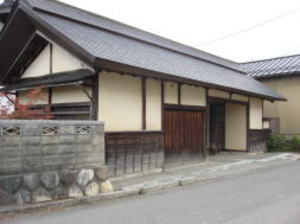
Near the east end of Aizu-Bange town and the west bank of the Ō-kawa river
(Aga-
kawa river), and it is located 500m south of Murata village in Miyako
district.
The time of the
open village of this village is not told in detail. The village is divided
into the east and west of
the Higashi(east)-Yashikizoe and the Nishi(west)-Yashikizoe.
In the Shinpen-Aizu-Fudoki, it
is description as Higashi-jyū(east-live) and Nishi-jyū (weast- live), it seems to had been a
current state at the time of the Fudoki compilation.
And in the Shinpen-Aizu-Fudoki, Ebisawa-
mansion, it is located in the village of Higashi-jyū. East-West 1-Chō (109m), North-South 1-Chō
10-Ken (127m). Has become a private house, there is a description that it is said that
it is a place
where the person who saysFujikura Kyūtarō Shigenobu lived. Although the
details of the year of
late Middle
period, it is a peaceful village and the mansion ruins which runs the
agriculture now.
The feudal administration period of Saikuna is, the river ferry-boat of
Sano (Sano district, Yugawa village, Kawanuma county) of
the Yonezawa-(Yonezawa city, Yamagata prefecture)-Kaidō road from Wakamatsu castle town, it is a place where there was a
wharf of boat on the Bange side. The cargo to and from Wakamatsu castle
town went from here to the castle town and Yonezawa-
Kaidō route. Saikuna village is according in the Aizu-Onko-Jyūyō-shō, when Mt. Bandai erupted and uplift in the Daidō 1 year
(806 year), and the Lake Inawashiro was subsidence, the name of the Saikuna
village is recorded in the village where 49 villages
sank in the bottom of the lake. It is said that the villagers who evacuated from here reclaimation the
area and built the village.
It is a village with Nichiren-sect Honkōzan Myōfuku-ji temple and Jizō-ji
temple.
(Welcome map, Aizu Bange town East area map)

Hasegawa Magozaemon, Kurosawa Gyōbuzaemon the three brothers were lived, their ancestors are descendans of Abe-no-
Sadatō’s younger brother Masatō. In the years of Tenshō years (1573 year
~ 1591 year), there is a description that became the
scale that East-West 50-Ken(91m), North-South 30-Ken(55m). In the Middle
period in Aizu-Bange town, it is a central figure of
the Mutsu and the Ōshū allied side of the Former 9 years war (1051 year ~ 1062 year), and the person who has the relation to
Abe-no-Sadatō lived there, weren’t they?
What is the hot water reservoir, the water temperature is low in the spring water in the mountainous area, because it is not
suitable as agricultural water, it is an irrigation facility used as agricultural
water after the water temperature is raised by
guiding water to a temporary reservoir.
(Welcome map, Aizu Bange town Funasugi,
Funakubo area map)
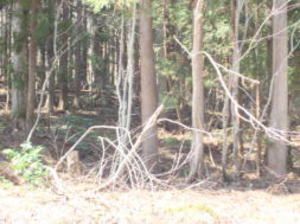
(1573 year ~ 1591 year), the Mr. Gamō's vassal Saze Kazusanokami lived.
Now Mr. Saze's descendants lives in Aizu-Wakamatsu
city.
2.
Nishi-Ushizawa-village-fortress, East-West 15-Ken (27m), North-South 19-Ken
(35m), build the younger brother Danjyō
Sanemoto of Sawara Akimori, it is said that it called Isome as family
name after in lives, the peoples of descendants still live here
today.
Mr. Sawara here, it is a family that corresponds to the distant relation
of Mr. Aizu-Ashina who is connected from the ancestor
Sawara Jyūrō Yoshitsura of the Ashina family. It seems the Inari shrine of the Torii in the photo was the residence god of
Ushizawa-mansion.
Mr. Aizu-Ashina of the Tenshō years was, at a time was involved in alliance and rupture, such as Uesugi Kagekatsu in Echigo
(Niigata prefecture). Satake Yoshishige of Hitachi (Ibaraki prefecture)
and Date Masamune of Yonezawa (Yonezawa city,
Yamagata prefecture) with he had repeated diplomatic negotiations and armed
conflicts. Mr. Uesugi take a neutral position of
Aizu and Date, in addition, Aizu formed an alliance with Mr. Satake through
the mediation of Mr. Uesugi, and the Ashina family
was inherited as the adopted child of the Ashina family of Satake Yoshihiro.
However, Date plotted the invasion of Aizu to the
last, ignoring Toyotomi Hideyoshi's restraint and invaded Aizu, driving
Mr. Ashina to the ruin.
Ushizawa village was, after the Meiji period, Wakamiya village office,
Ushikawa elementary school, and Aizu-Bange Police
Station Ushizawa police satellite office were located, it was also the
administrative the center of the Wakamiya district. Now,
everything is integrated into Aizu-Bange town.
(Welcome map, Aizu Bange
town South area map)
South from the front of Bange Kōsei Hospital, cross the railroad crossing
of JR Tadami Line,
the mansion ruins of a vassal of Mr. Ashina, located in the Ushizawa village
in the Ushikawa
district, about 2km away. The area on the north side of Sōtō sect Daitoku-ji
temple is the ruins
of Ushizawa-mansion, but it is a residential area and no evidence of the mansion remains is
retained.
In the Aizu-Kagami describes that there was a residence by two peoples
in Ushizawa
area.
1.
It is said that the Ushizawa-village-fortress was built, East-West 30-Ken
(55m), North-South
60-Ken (109m), and Sawara Umanosuke Akimori was built, and at the time of Tenshō years
long time. The place name of Magarinuma is, it has been reported that there was a big swamp of the hexagon in the north of
this village in old times. Looking at Mt. Bandai (altitude 1817m) in the
distance, and located near the flow of the Ō-kawa river
(Aga-kawa river), in the period when large-scale shore protection work is not possible, it can be imagined that the view of the
Aizu plain, where many rivers and swamps and wetlands are spreading, would have been widespread. The separation flow of
the Tsurunuma-gawa river at that time, and the main stream and the tributary
of Ō-kawa river (Aga-kawa river) are while
confused, it flows in the vicinity of the ruins of this mansion, and it must have been a natural moat. In the Aizu-Kagami has
become a "Magarinuma-village-fortress", East-West 21-Ken (38m),
North-South 24-Ken (43m), it is written Ōnuma Danjyō
Hidemasa was lived. In the time of Tenshō period (1573 year ~1591 year),
it is the ruins of the Jitō (lord of the manor) of
Mr. Ashina’s vassal. During the invasion of Aizu by Date Masamune in Tenshō 17 year (1589 year), it was caught in a fire
caused by war, it seems that it was not reused because the management
system in the territory changed from the rule of
Mr. Gamō. It is the "all that remains, of warrior’s dreams" of
400 years ago.
(Welcome map, Aizu Bange town Norht-West area
map)
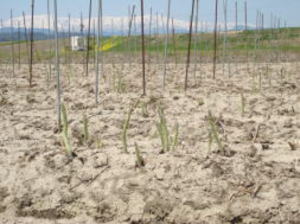
From the front of Hiroki Sake Brewery in Aizu-Bange town, go north on the
Kitakata-Kaidō
road, in addition about 1km to the right the intersection in front of
Meguro Kōji shop, the
area that has become a arable land and a cemetery behind the "Soba shop Kurumaya" of
Numakoshi village is the ruins of Magarinuma-mansion. The area where the
vinyl-house in
the photo stands is to say the remains of the mansion.
Numakoshi village is, the
Magarinuma village and the Sunakoshi village were merged in Meiji 8 year (1875 year) and
became a Numakoshi, in the Tōdera Hachiman Shinto priest list of Tengi
5 year (1057 year)
of the Ihon-Tōdera-Nagachō, the village name of Magarinuma is described
and opened for a
Push the page bottan
high temperature times is harvested twice a day, which spurs the busyness. "Green Asparagus", is a common green asparagus,
"White Asparagus" was grown by blocking the sunlight the green
asparagus, purple asparagus is called "Purple Asparagus" and
contains a lot of anthocyanins. We are eating the new sprout part of asparagus.
Asparagus is not only dietary fiber, 93% are
water, it contains a wide variety of vitamins and minerals, including vitamin A, vitamin B1, B2, vitamin C, vitamin E, Aspartic
acid and Rutin. Aspartic acid is said to be effective in recovering fatigue
and increasing stamina. Moreover, it is said that it is
effective in the function recovery of the kidney and the liver by the diuretic action. Rutin strengthens blood vessels and is effective
in preventing high blood pressure and arteriosclerosis. There are methods of cooking, such as boiling, frying, and baking.
(Welcome map, Aizu Bange town East area map)
Aizu Asparagus
Aizu is the 3rd place
the planting area in Japan
Road station Aizu Yugawa·
Aizu-Bange
Hirukawa-fortress
ruins
West of Aizu-Bange town. From Sugi Yakushi in the Sugi settlements to 0.8 km south of the
old road Tōdera-Akaru line (Hattan-road), it is located in the Funakubo settlements.
According to the description of the Aizu-Kagami the Funakubo-village-fortress,
it is said that
Abe Izumonokami Michiyasu the samurai (in charge of security and security at the temple) of
Ōdera (Enichi-ji temple, Bandai-town, Yama county, Fukushima prefecture),
built it on a scale
East-West 40-Ken (73m) North-South 21-Ken (38m). It is said that the Kurosawa Kaname
lived later. It is thought that this Kurosawa Kaname is one of the clan
of Mr. Kurosawa who is
one of the three brothers of the owner of Sugi-mansion. Details of the
year of built the castle is
unknown. After Abe Izumonokami Michiyasu was built, the village was impoverished by
famine
Kanagami district in the east of Aizu-Bange town. The settlements along
the South-trunk-road
beside Tsurunuma stadium is Fukuhara settlements. In the place where it was a riverbed of
Tsurunuma-gawa river of ancient times, of the marks that the main stream moved to Ō-kawa
river (Aga-kawa river) by the Shirohige-no-Ōmizu (big flood of the white
beard) of Tenbun 5 year
(1536 year). It is a village which was established by land reclamation the common name
Fukukawahara. In Shinpen-Aizu-Fudoki, there is a description that the Fukuhara Kazaemon
of the Kimoiri, opens Fukuhara-new-rice-field-village in Kawanuma county
in Genna 9 year
(1623 year). At the same time, it is said that Tokushō-ji temple was built
by inviting the monk
Rin-etsu, of the Zen Buddhism.
Fukuhara-mansion
ruins
The east end of Aizu-Bange town, it is located in the northwestern part of Saikuna village
along the Miya-gawa river. In the Aizu-Kagami, East-West 31-Ken (56m), North-South
22-Ken (40m), it is called Fukumori-fortress. Minagawa Jirō Yoshimura
was lived here and
there is a describe in later made to family name the Fukumori. The year of built the castle is
unknown, but I think it is the end of the Mr. Ashina rule period. In Tenshō
17 year (1589
year), I think that it was attacked at the time of the Aizu invasion of
Date Masamune and
fortress felled. The current situation is a private house, and the ruins of the earthworks and
the ruins of the moat are left very little. Leaving a little remnant of the chaotic times of the.
turned into a residential area in later years. The trace of the earthworks of the mansion is left in the vicinity of Inari shrine in
the northern part of the settlements. The height of the Inari shrine in
the photo is presumed to be a remnant of a part of the
earthworks.
In the old days, there were many Tsuka (Kofun), it is said so it said "Tsuka-hara(field)",
or the occurrence of the
place name of the Tsukahara is, when horse grazing flourished in the area around Bange in the Middle period, it is said that the
reason is that the grass for horse feed were harvested and bundled. It
is said that the horse produced in Bange in the Middle
period was presented to Kamakura and Kyoto far away. Especially Minamoto-no-Yoritomo
of Kamakura and Oda Nobunaga of
Azuchi-jyō castle in later years, it is said that it liked the horse from Aizu very much. Mr. Ashina, the lord of Aizu in the Middle
period, was trying to strengthen the relationship with the talented people
of time by offering horses and others from Aizu.
(Welcome map, Aizu Bange
town East area map)
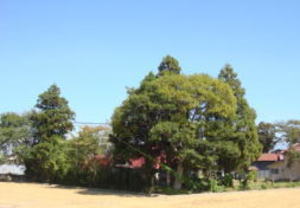
It is recorded that it was in the Tsukahara settlements near the Ō-kawa
river (Aga-kawa
river), in the east end of Aizu-Bange town. In the Aizu-Kagami the Tsukahara-fortress,
East-West 36-Ken (66m), North-South 40-Ken (73m). Ninagawa-Shōgen-Toshikage he was
build and lived in Jyōwa 2 year (1313 year). The descendants make Tsukahara
a family
name. At the time of Tenbun years (1532 year ~ 1554 year), Satō Yūmanosuke
Yoriharu
lived, it is said that the descendants made Tsukahara a family name. In addition, the
residence of Mr. Ashina's vassal Hirata Hyōbu Shōyū is located in the
north of the village,
the scale is East-West 2-Chō 20-Ken (248m), North-South 2-Chō 10-Ken (230m).
It seems
that there was a fairly large mansion, but it was damaged by repeated
floods, and it has been
(1842 year) and closed-kiln in Meiji 19 year (1886 year). There were three
potter kilns in the Sugi district, but it seems to have
gone out of business at the same time as closing the kiln. Moreover, it
is said the Aizu clan was dispatching the leader from Hongō
(Hongō district, Aizu-Misato town, Ōnuma county). The structure of the kiln was a structure of the Ōbori-Sōma-ware-type (Ōbori
district, Namie town, Fukushima prefecture), and it seems to have been
a completely different structure from Hongō- ware.
The Aizu clan was dispatched Aizu-Hongō-ware Tile-master Kashiwagi Hyōgo
as it was leader. It is recorded that the porcelain
clay was mined from Mt. Byakkosawa in the southwest of the Sugi village. The first national industrial exhibition of the advocated
by Ōkubo Toshimichi in the Meiji 9 year (1876 year) was held in the Meiji
10 year (1877 year), and there are in the list of exhibits,
"Teacups 16, iron color, Yukihira 17, Suzuki Kojirō, Funasugi village,
Kawanuma county, Iwashiro country"(old name of Aizu).
It is said Mr. Suzuki Kojirō of Funasugi village, Kawanuma county exhibited 16 iron-glazed teacups made of pottery and the 17
Yukihira. Yukihira is a type of tableware and cooking utensils. It is
a clay pot shaped no lid and like a large teapot with a spout
and handle. It is mainly used when boil porridge in modern times. It is called a Yukihira-pot, named after the reason Ariwara- no-Yukihira that made burned salt from seawater. In the excavation, a large number of pottery pieces were excavated from around
the kiln ruins. In addition to pottery pieces and Hongō-ware, it seems
to have been a wide variety of things such as dyeing
porcelain of China, Hizen, Seto, Ōbori-Sōma, Karatsu, and Mino. There
are seemed to have been a reference of pottery. Pottery
seems to have been a thing to use as a daily miscellaneous ware, such as tableware, Buddhist tools in Tsuruga-jyō castle, it seems
that all the things that were put out from the kiln were carried into
the castle. Mr. Kashiwagi Hyōgo of the Tile-master is, a person
who was a potter’s craftsman who burnt the roof-tile of Tsuruga-jyō castle.
As an employment measure in the not busy the
government-kiln for the roof-tile burning, it might have burnt the miscellaneous
ware for daily use in the castle.
A little trivia is
here. The person named Ariwara-no-Yukihira was a poeter of the early Heian
period, it is a court noble who was promoted to the
government position called the Chūnagon. It is an elder brother of Ariwara-no-Narihira
who is also a poeter, and is super famous
by Hyakunin-Isshu (100 poems by 100 famous poets).
(Welcome map, Aizu Bange
town Funasugi, Funakubo area map)
West of Aizu-Bange town. Along the old prefectural road Tōdera-Akaru line about 250m south
from the railroad crossing of JR Tadami line in front of Sugi Yakushi
of Sugi settlements, it is
said that the area around the field in the south of the hot water reservoir
is the ruins of the
building. The current situation is farm land. It is located in a hilly area with a view of the
entire of Aizu-Bange town. Actually, this road is the Echigo-Kaido road
of ancient times.
In addition, it was also a getaway route of "a phantom thief of Tōdera
Hattan (introduced at
Mannenzan Senyo-ji temple)".
In the Aizu-Kagami, Fortress, East-West 28-Ken (51m), North-
South 20-Ken (36m), it was Tajiri Yamato built and lived of its descendants,
Tajiri
Izumi,
Sugi-mansion ruins
Ushizawa-mansion
ruins
Magarinuma-mansion
ruins
It is located 500m
east of Funakubo settlements.
In the Aizu-Kagami, Hirukawa-fortress, East-West 31-Ken (56m), North-South 22-Ken (40m).
It is called the Hirukawa-mansion that Ueno Kaganokami Hidekage builds.
It is said in the
Tenshō years (1573 year ~ 1593 year), Hasegawa Kageyu lived. The year
of built the castle is
unknown, but I think it is the Genki years (1570 year ~ 1573 year) from Tenbun years (1532
year ~ 1555 year) of the reign of Mr. Ashina Moriuji. The original Hirukawa settlements was,
the northeast of the Hirukawa-bashi bridge over the Kurimura-weir near
Wakamatsu Gas Co.,
Ltd. Bange store, in the middle between the present National route 49,
Bange and Tōdera.
Ebisawa-mansion
ruins
Mr. Shibuya Tōma is a person who was active in Aizu at Tenpō 3 year (1832
year) ~ Meiji 37
year (1904 year). He was born in Bange village (Aizu-Bange town, Kawanuma
county,
Fukushima prefectuere) as the 3rd son of Aizu clan doctor Namae Hirotaka. In addition, the
Shibuya family is a family of a former Aizu clan doctor, but because there
was no boy and it
was a dead-family, Tōma is received as an adopted son and it revives.
Child’s name is
Sadayasu, grow up and named to Masasuke, Tōma is a martial arts name of Ono-ha (school)
Ittō-ryū. The master of the sword is unknown, but it is said that he has
mastered the Ono-ha
Ittō-ryū of combative swordmanship. He also excels Sinology (Chinese classics), opened "Yōki-
kan", a cram school in scholarship and the martial arts. In Bange
village, he put a lot of effort
into educating to children in the area.The place where there was "old Nihei clinic" in Kobara
Ono-ha Ittō-ryū Yōkikan-dōjyō ruins
Aizu clan doctor
Shibuya Tōma residence ruins
It is located in Yugawa village, Kawanuma county, but Aizu-Bange town is
also involved in
investment and management, so it will be introduce. The nickname is "Navel
of Aizu", which
was chosen by the public offering. It literally opened on October 2, 2014
in the middle of the
Aizu Basin. From Aizu-Wakamatsu city, take national route 49 or Prefectural
route 33 toward
Aizu-Bange, it is located in front of Miyako-bashi bridge over the Ō-kawa rever (Aga-kawa river)
where the two roads intersect. In the car navigation system, if you enter
"Fukushima prefecture,
Kawamuma county, Yugawa village, Ōaza Sanome, aza Gochō-no-me, 78-1",
you should be able
to navigate. The building of the station is woody which uses a lot of wood
from Aizu, the ceiling is
Ms Nakano Takeko's birth and the end of life were introduced in "Bange
Go-zan (five temples)
Hokkai-ji temple", but let's introduce it a little more. Ms Takeko
who was born in the Wadakura-
mon gate Aizu clan residence in Edo-jyō castle (current Imperial Palace).
She was very
intelligent, when she was five or six years old, she would recite it "Ogura Hyakunin-Isshu" and
she had never made a mistake one word. Her father, Nakano Heinai, was
a master of calligraphy
and said was passionate about educating children (Takeko, Toyonori, Yūko).
Daisuke Akaoka, a
member of the Aizu clan who was the martial artist of Mr. Matsudaira Katamori's sister-in-law
Teru-hime (princess), was a good teacher excels at Bunbu (learning and
martial arts) of the Aizu
clan, and because he was a moral person, he put Takeko in the pupil and
let him learn. Akaoka
Daisuke is amazed at Takeko's cleverness, and entreat to Heinai to adopted
daughter.
Tamaki Dōjyō ruins
Heroine of
Boshin-war Ms Nakano Takeko the site of stay Bange
Funakubo-fortress
ruins
Saikuna-mansion
ruins
Tsukahara-mansion
ruins
Do you know the peoples live in Aizu-Bange town, that there was a time when pottery was
baked in Aizu-Bange in the old days?
The west rear of Sugi-mansion ruins in the Sugi district,
the back of the cedar grove along the old prefectural road Tōdera-Akaru line is the Sugi-kiln
ruins. In part, there is a new road passing on the Tōdera-Akaru line.
The results of excavation
survey sat before the construction of the new road by the Aizu-Bange town
board of education,
four of the Renbōshiki-Noborigama (the connecting-structure-climbing type kiln) ruins have
been confirmed. There is a describe of the Sugi-kiln in Hongō ware material
"the Tile-master,
Kashiwagi Hyōgo Work-book". It is recorded that the kiln was kilns-built in Tenpō 13 year
Sugi-kiln ruins












